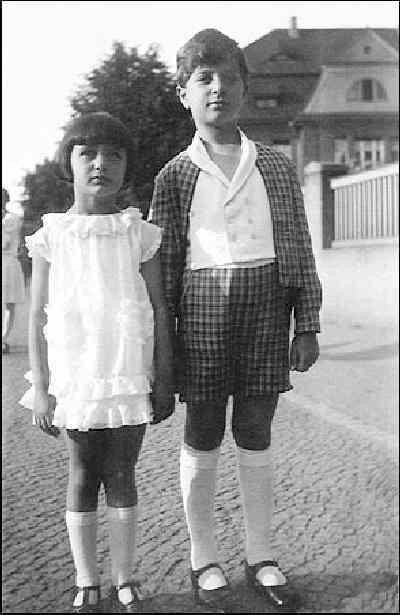
Strap Shoes: Hoisery--White Kneesocks

Figure 1.--HBC is not sure where this photograph was taken, but we speculate Germany in the late 1920s. We would be interested in HBC's readers have any thoughts on this. Notice the difference in the shoes and the fact that the girl has not pulled her kneesocks.
|
White kneesocks appeared in the 1900s, but they were not commonly worn until the 1920s. In the first two decades of the 20th century, three-quarter length socks and
long stockings were more common than kneesocks. We have noted boys wearing white kneesocks with strap shoes most commonly in the 1920s and 30s. In appears to
have been most common in Europe, countries like France and Germany and to a lesser extent Britain. American boys also wore them, but to a lesser extemt. There were
different weights of white knee socks. Lengths also varied as some were worn cuffed. This appears to have been a style most commonly worn by younger boys. There was also an element of social class involved.
The most common color of strap shoe worn with white kneesocks was black, but colored shoes were also worn. This was a dressy style. It was most commonly worn
with some kind of juvenile suit or a fancy blouse.
Chronology
White kneesocks appeared in the 1900s, but they were not commonly worn until the 1920s. In the first two decades of the 20th century, three-quarter length socks and
long stockings were more common than kneesocks. We have noted boys wearing white kneesocks with strap shoes most commonly in the 1920s and 30s. We have noted boys wearing strap shoes with white kneesocks later even into the 1980s, but after the 1930s the style becomes increasingly worn by boys from wealthy, even arostoctaric familes.
Nationality
Boys wearing white kneesocks with strap shoes appears to
have been most common in Europe, countries like France and Germany and to a lesser extent Britain. American boys also wore them, but to a lesser extemt.
Weights
There were different weights of white knee socks. Some kneesocks were quite heavy. Perhaps the haeaviest were worn with kilts. Other kneesocks, especially those for formal events could be sheer/
Material
Lengths
Lengths also varied. Some extended to lengths above the knee. These were worn cuffed. Others had just enough length to reach the bottom of the knee. Boys often were photographed with their kneesocks falling down. Note that with white kneesocks, you rarey see this. The boys have their socks pulled smartly upmto the knee.
Age
Stap shoes and white kneesocks appears to have been a style most commonly worn by younger boys. This has varied over time. By the 1960s this was prinmarily a stykle for pre-school boys. Earlier older boys might wear strap shoes with white kneesocks, but rarely into their teen years.
Social Class
There was also an element of social class involved. Working class boys rarely wore strap shoes with white kneesocks. But during the 1920s and 30s it was not just a style for rich children. Children from middle class families might wear strap shoes and white kneesocks, albeit usuallybaffluent families or at leasr middle class families with social pretensions. After the 1930s it became increasingly it became a style associated with wealthy, even arostoctaric familes, or a style reserved for formal events like weddings.
Gender
Todau white kneesocks and strap shoes has rather a girlish look about it. This was not always the case. Earlier it was considered a childish style, but one suitable for either boys or girls.
Shoe Color
The most common color of strap shoe worn with white kneesocks was black, but colored shoes were also worn.
Clothes
This was prinarily worn as a dressy style, especially for black strap shoes. It was most commonly worn with some kind of juvenile suit or a fancy blouse. British boys some times wore kilts with strap shoes and white kneesoicks, but anglets were more common. The colored strap shoes wre less formal, even play shoes. Thus boys wearing colored strap shoes with white kneesocks might wear play clothes.
Individual Boys
HBC has archived several outfits worn by boys that we believe require examination in some detail.
We note a photograph of a boy in a checked suit posed with his sister. The photograph is not identified, unfortunately. We estimate that it was probably taken in Germany. The style looks vaguely German, as does the cobled street and house. France is, however, another possdibility. We would date it to the late 1920s. The boy's checked suit looks almost home made. He wears it with a unsusual little collared vest.
Christopher Wagner

Navigate the Boys' Historical Clothing Strap Shoe-related Pages:
[Return to the Main strap shoe sock page]
[White knee socks]
[Sand shoes]
[Pinafores]
[Smocks]
[Kilts]
[Ringlet curls]
[Fauntleroy suits]
[Buster Brown suits]
[Ring bearers]
Navigate the Boys' Historical Clothing Web Site:
[Introduction]
[Activities]
[Bibliographies]
[Biographies]
[Chronology]
[Clothing styles]
[Contributions]
[Countries]
[Boys' Clothing Home]
Created: September 5, 2001
Last updated: September 5, 2001



